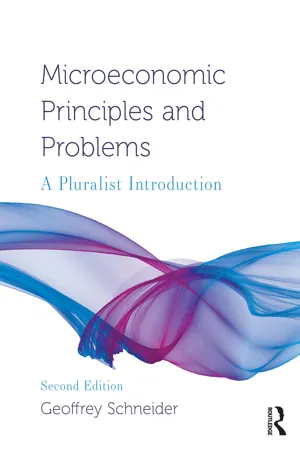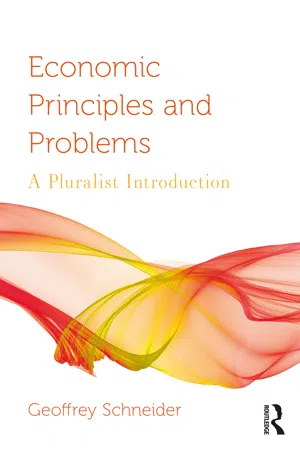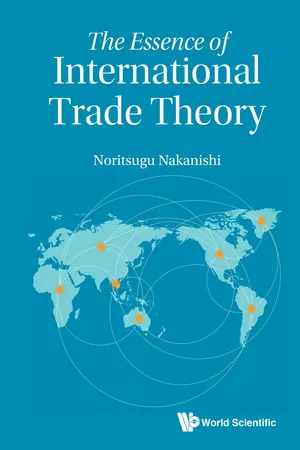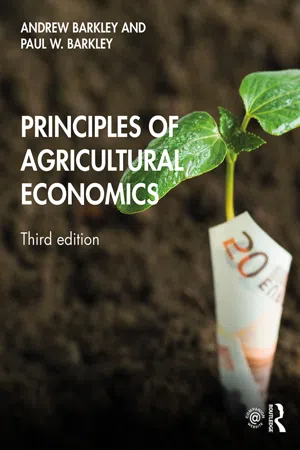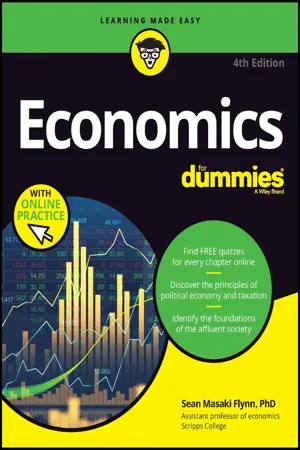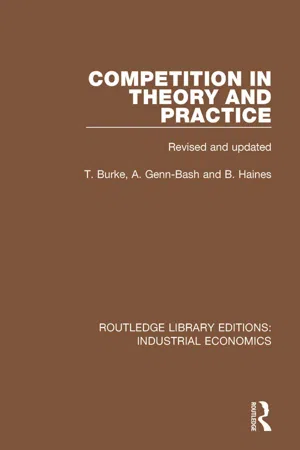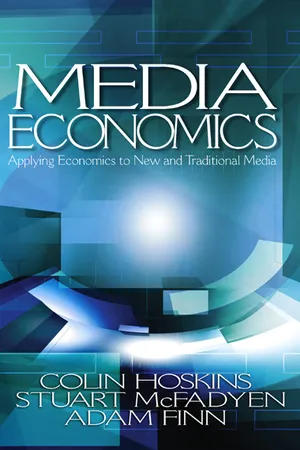Economics
Monopolistically Competitive Firms
Monopolistically competitive firms are characterized by a market structure where many firms offer differentiated products, giving them some degree of market power. This allows firms to set prices above marginal cost, but they still face competition from similar products. In the long run, firms in this market structure can earn only normal profits due to low barriers to entry.
Written by Perlego with AI-assistance
Related key terms
Related key terms
1 of 4
Related key terms
1 of 3
9 Key excerpts on "Monopolistically Competitive Firms"
- eBook - ePub
Microeconomic Principles and Problems
A Pluralist Introduction
- Geoffrey Schneider(Author)
- 2024(Publication Date)
- Routledge(Publisher)
Monopolistic competition is a market very similar to perfect competition, but there is one major difference: Firms in a monopolistically competitive market have a monopoly on one unique aspect of the market. This product differentiation allows some firms to charge higher prices than others, which is not possible in a perfectly competitive market.12.3 MONOPOLISTIC COMPETITION
Monopolistic competition is another very competitive market structure with a large number of small firms due to easy entry into the market. Unlike in perfect competition, firms have a monopoly over certain unique business characteristics such as quality, brand, or location. This gives firms some control over their prices. Firms supply goods that are close but not perfect substitutes for each other. Examples include local services such as doctors, dentists, and lawyers, and local retailers such as restaurants, bars, and gas stations. Businesses in all of these industries offer a similar product, but some can charge a higher price than others due to the differences in quality, brand, and location.The major characteristics of a monopolistically competitive market are as follows:- Slightly differentiated products: Goods are close but not perfect substitutes for each other. If firms can successfully improve quality and establish brand name recognition, they can further differentiate their product from competing ones.
- Large number of sellers and buyers: The large number of competitors and consumers means that no one actor has a large influence over the market. Some firms are larger than others, but no firm is dominant.
- Easy entry and exit:
- eBook - ePub
- Neva Goodwin, Jonathan M. Harris, Julie A. Nelson, Pratistha Joshi Rajkarnikar, Brian Roach, Mariano Torras(Authors)
- 2022(Publication Date)
- Routledge(Publisher)
Figure 17.5 . This will cut into the existing firms’ revenues and profits. How many new firms will enter, and how much will demand fall for any one firm? In theory, demand will fall just up to the point where every firm is making zero economic profits. (See the Appendix to this chapter for a graphical explanation.)Like the monopolist, the monopolistically competitive firm faces a downward-sloping demand curve and so produces less, and charges a higher price, than a perfectly competitive firm. As in the case of a perfectly competitive firm, however, free entry and exit in monopolistically competitive markets means that any positive economic profits to be gained should only be temporary, as new competitors move in to exploit new opportunities to earn profits.3.4 Monopolistic Competition and Long-Run Efficiency
Compared with perfectly competitive firms, Monopolistically Competitive Firms produce less output and charge higher prices. Like monopolies, they stop short of producing at levels where the social marginal benefit of production is just equal to the social marginal cost. It can also be shown (in the Appendix to this chapter) that such firms have higher unit costs than would occur in a perfectly competitive market. In short, they operate inefficiently.Monopolistically Competitive Firms may, like monopolists, expend considerable resources to protect their miniature monopoly. Though perhaps unable to keep competitors from entering their general industry, they can try, increasingly, to differentiate their product. Firms in this kind of market structure are observed to engage in a great deal of nonprice competition . That is, they compete with other producers by advertising heavily in order to make buyers want their products and by using attractive signs and packaging, selecting better locations, varying their hours of operation, and so on.nonprice competition: competition through activities other than setting prices, such as advertising and locationIn terms of social benefit, it seems evident that resources would be better spent producing fewer varieties of goods and services, at lower costs, and with less advertising. However, some cast a more positive light on the problem, focusing instead on the notion of consumer sovereignty. They argue that inefficiencies in production are merely the price that must be paid to satisfy consumers’ desire for variety (and, presumably, also for massive advertising and flashy packaging). Although probably not the whole story, it may very well be that the highest social benefit lies somewhere between completely standardized products and the extreme proliferation of consumer goods that we currently observe. - eBook - ePub
Economic Principles and Problems
A Pluralist Introduction
- Geoffrey Schneider(Author)
- 2021(Publication Date)
- Routledge(Publisher)
Monopolistic competition is a market very similar to perfect competition, but there is one major difference: Firms in a monopolistically competitive market have a monopoly on one unique aspect of the market. This product differentiation allows some firms to charge higher prices than others, which is not possible in a perfectly competitive market.12.3 Monopolistic competition
Monopolistic competition is another very competitive market structure with a large number of small firms due to easy entry into the market. Unlike in perfect competition, firms have a monopoly over certain unique business characteristics such as quality, brand, or location. This gives firms some control over their prices. Firms supply goods that are close but not perfect substitutes for each other. Examples include local services such as doctors, dentists, and lawyers and local retailers such as restaurants, bars, and gas stations. Businesses in all of these industries offer a similar product, but some can charge a higher price than others due to the differences in quality, brand, and location.The major characteristics of a monopolistically competitive market are as follows:- Slightly differentiated products: Goods are close but not perfect substitutes for each other. If firms can successfully improve quality and establish brand name recognition, they can further differentiate their product from competing ones.
- Large number of sellers and buyers: The large number of competitors and consumers means that no one actor has a large influence over the market. Some firms are larger than others but no firm is dominant.
- Easy entry and exit
- eBook - ePub
- Noritsugu Nakanishi(Author)
- 2018(Publication Date)
- WSPC(Publisher)
Chapter 6Monopolistic Competition
We develop models incorporating monopolistic competition, which are characterized by the increasing-returns-to-scale technology and product differentiation. The monopolistically competitive models have been first introduced to international trade theory in order to explain so-called intra-industry trade — the phenomenon that goods or services within the same category of a certain classification are exchanged internationally. Since then, they have been applied to various topics that are difficult (sometimes, impossible) to explain within the framework of classical theories of comparative advantage based on perfect competition.Earlier models of monopolistic competition heavily rely on the assumption of technological symmetry among firms.1 Stimulated by the recent empirical findings that firms even within the same industry have different characteristics and diversified productivities, the monopolistically competitive models have been modified so as to suitably incorporate such firm heterogeneity. Moreover, the development of monopolistically competitive models has brought about a renewal or a revival of a branch of economics that examines geographic characteristics of an economy such as locational decisions and distribution of economic agents (firms and/or workers), regional concentration of industries, formation of cities, and others. This is now known as the New Economic Geography (NEG) or Spatial Economics.6.1Product Differentiation
Suppose that there are two goods of which basic functions are the same. When consumers can distinguish one good from the other by such non-price aspects as qualities, colors, trademarks, logos, brand names, packaging, after-sales services, and so forth, we say that these goods are differentiated. When goods are distinguished by their qualities (from low to high), this is called vertical differentiation; other cases are called horizontal differentiation - eBook - ePub
- Andrew Barkley, Paul W. Barkley(Authors)
- 2020(Publication Date)
- Routledge(Publisher)
Market Power —The ability to affect the price of output. A firm with market power faces a downward-sloping demand curve.Market Structure —The organization of an industry, typically defined by the number of firms in an industry.Monopolistic Competition —A market structure defined by (1) many sellers; (2) a product with close, but differentiated, substitutes; (3) some freedom of entry and exit; and (4) some availability of knowledge and information.Monopoly —A market structure characterized by a single seller.Oligopoly —A market structure characterized by a few large firms.Perfect Competition —A market or industry that has four characteristics: (1) numerous buyers and sellers, (2) homogeneous products, (3) freedom of entry and exit, and (4) perfect information.12.8 Chapter 12 review questions
- Which type of firm has complete market power?
- monopoly
- competitive firm
- oligopoly
- monopolistic competition
- Which good may be a homogeneous product?
- furniture
- automobile
- wheat
- toothpaste
- A competitive firm is a(n):
- oligopolist
- price maker
- price taker
- monopolist
- The demand curve facing an individual firm in a competitive industry is:
- perfectly elastic
- perfectly inelastic
- the aggregate demand curve
- equal to the supply curve
- Competition results in:
- monopoly prices
- prices higher than the cost of production
- eBook - ePub
Economics For Dummies
Book + Chapter Quizzes Online
- Sean Masaki Flynn(Author)
- 2023(Publication Date)
- For Dummies(Publisher)
Chapter 7 ). This section provides an overview of monopolistic competition.Benefiting from product differentiation
Like competitive firms operating in free markets, industries featuring monopolistic competition have lots of firms competing against each other. But unlike competitive free markets where all the firms in an industry sell an identical product, in monopolistic competition each firm’s product is at least slightly different.Think of the market for gasoline. Any large city has dozens, if not hundreds, of gas stations — all selling gasoline that’s pretty much the same. But if you look at each gas station with a little wider scope, you notice that each one sells a product that’s at least slightly different from the product its competitors sell. For instance, some stations have mini-marts, and others have car washes or provide fuel with special additives designed to improve engine performance. And crucially, each gas station is clearly differentiated from all the others because it has a unique location — something that’s important to people who live nearby or are desperate because their car is running on its last fumes.Economists use the term product differentiation to describe the things that make each firm’s product a different from its competitors’ products. The overall result of these differences is that they decrease the intensity of competition at least a little bit. Your local gas station, for instance, may be able to get away with charging you a few cents more per gallon than its competitors if it has nice facilities and the next-closest competitor is several miles away.On the other hand, there’s still a lot of competitive pressure in the industry. Although your local station may be able to use its unique characteristics to get away with charging you a little more, it couldn’t charge you a lot more — if it tried to do that, you’d take your business to one of its competitors. - eBook - ePub
The Microeconomics of Wellbeing and Sustainability
Recasting the Economic Process
- Leonardo Becchetti, Luigino Bruni, Stefano Zamagni(Authors)
- 2019(Publication Date)
- Academic Press(Publisher)
This criticism suffers from a weakness, which Chamberlin himself pointed out: it overlooks the fact that differentiation is linked to consumer preferences, who are often willing to pay a higher price in order to have the possibility of choosing from among different varieties of the same type of good. This is as if to say that product diversity comes at a price. Said another way, the possibility of actually being able to make a choice is a positive argument in consumers' utility functions, who show that they increasingly appreciate its value. Regarding the comparison with a monopoly, note that over the long run extra profits are zero in both perfect and monopolistic competition. A monopoly enterprise, however, can earn extra profits even over the long run as long as it is able to maintain the entry barriers it set up for its protection. Finally, we observe that resources are inefficiently allocated in both a monopoly and in monopolistic competition.6.5. An oligopolistic market
6.5.1. Its distinctive characteristics
An oligopoly is a market structure in which several companies operate, but none of them have a negligible market share (as happens in perfect competition). Every oligopolistic enterprise is thus able to exercise a certain influence on the relevant price and/or quantity variables and is aware that other companies operating in the sector can, by their decisions, do the same. The distinctive nature of an oligopolistic structure is that there is strategic interaction between companies; such interaction is absent in a monopoly and in perfect competition, in which companies, taking price as a given, behave atomistically.Consider a duopoly, or a market in which there are only two suppliers and multiple buyers. In addition to company A , another company B produces and sells an identical product as its rival. Suppose the two companies know the behavior of the good's consumers, summarized by the demand function p=f (q ); p indicates the price and q indicates the total output, which is equal to the sum of qAand qB, representing the production levels of the two companies A and B respectively. For the sake of simplicity, assume that production costs are zero. If each company independently chooses its output level to maximize its profits (indicated by π ), then firm A chooses qAto maximize πA=pqA=f (qA+qB)qA. As we see, πAalso depends on qB; that is, A 's optimal output level choice is no longer independent of the output level simultaneously chosen by the other company, as it is in perfect competition. Thus there is no demand curve for an individual company in an oligopoly; the quantity of product an oligopolist can sell at a certain price depends on what its rivals do. This is why an oligopolist can never know with certainty - eBook - ePub
- Terry Burke, Angela Genn-Bash, Brian Haines(Authors)
- 2018(Publication Date)
- Routledge(Publisher)
If public goods, such as defence, are provided at all in a free market economy they are likely to be provided at a suboptimal level. In addition to public goods, the existence of externalities are another reason why perfect competition may not achieve an optimal resource allocation. There is no guarantee that an optimal distribution of income will occur under perfect competition. Also diseconomies of scale must exist and indeed occur beyond a relatively small level of output. The efficient size of firm must be small enough for the industry to efficiently support a very large number of firms.However, empirical evidence on this latter point suggests that the long-run average cost curve does not turn upwards over feasible output levels in most industries. This implies that small firms have an incentive to expand their size and reap the benefits of lower unit costs. Also, economies of scale imply that the marginal cost curve will be below the average cost curve and the profit maximising rule of setting price equal to marginal cost under perfect competition will result in financial losses for the firm.These various problems associated with perfect competition resulted in the development of other theories of competitive behaviour, such as the theory of monopolistic competition which we will consider next.Monopolistic competitionThis theory was developed by Chamberlin (1933). It applies to market situations where a large number of firms are selling similar but differentiated products. Competition would not only apply to the price charged but also to the quality of the product, labelling, advertising and sales promotion. Hence non-price competition is important in such markets.As in perfect competition the assumption of free entry into and exit from the market still applies. Unlike perfect competition each good is slightly different in composition or brand image. For instance, different brands of toothpaste or detergents are similar but not identical to one another. As a result each firm does not face a perfectly elastic demand curve for its product and hence is not a price taker. The firm’s demand curve is downward sloping under conditions of monopolistic competition. One firm may charge a higher price than its rivals without losing all its customers due to brand loyalty for its product. Although supernormal profits are possible in the short run, because of the free entry assumption, only normal profits will be made in the long run. In other words, new firms would be attracted into the industry in the long run if short-run supernormal profits are being earned. The result of this new entry will be that each individual firm will be unable to operate at full capacity. Average costs of production will not be minimised and hence firms will be producing inefficiently. Figure 3.1 - eBook - ePub
Media Economics
Applying Economics to New and Traditional Media
- Colin Hoskins, Stuart M. McFadyen, Adam Finn(Authors)
- 2004(Publication Date)
- SAGE Publications, Inc(Publisher)
chapter 8 , applies with even more force to oligopoly. Oligopolists are large enough to afford substantial, organized, R&D activities. Competition is usually strong enough to force them to be innovative to survive and flourish. The barriers to entry permit the companies to enjoy the fruits of successful innovation in terms of economic profits in the long run (an incentive for innovation not present under monopolistic competition). Certainly many oligopolistic companies and industries are extraordinarily innovative. Consider, for example, producers of consumer electronic goods such as Sony, Matsushita, and Philips.9.4.4 EquityAs price under monopolistic competition is typically less than under oligopoly, and the oligopolistic firm may enjoy economic profits in the long run, monopolistic competition is generally more equitable for the consumer. However, if a government considers that a cross-subsidy, such as between long distance and local telephone services, is desirable in the name of equity, an oligopolistic industry could sustain such a cross-subsidy, although a monopolistic competitive industry could not. The reason is the same as that discussed in the last chapter in the comparison of perfect competition and monopoly. Long-run economic profits are necessary to make cross-subsidy feasible.9.4.5 Cultural and Other Nonprofit GoalsAs we argued in chapter 8 , economic profits in the long run are necessary if firms are to be persuaded, or required, by a regulatory agency to further cultural goals at the expense of profit. Similarly, the opportunity to earn economic profits in the long run permits other goals to be pursued willingly. In the context of this chapter, oligopolies may permit other goals to be pursued, but monopolistic competitors will not unless compensated by government or other subsidies.9.4.6 DiversityBoth monopolistic competition and oligopoly, unlike perfect competition and monopoly, provide the consumer with product choice. Monopolistic competition is ideal from this perspective: Witness the wide choice of magazines available and the almost infinite selection of books.
Index pages curate the most relevant extracts from our library of academic textbooks. They’ve been created using an in-house natural language model (NLM), each adding context and meaning to key research topics.
Explore more topic indexes
Explore more topic indexes
1 of 6
Explore more topic indexes
1 of 4
